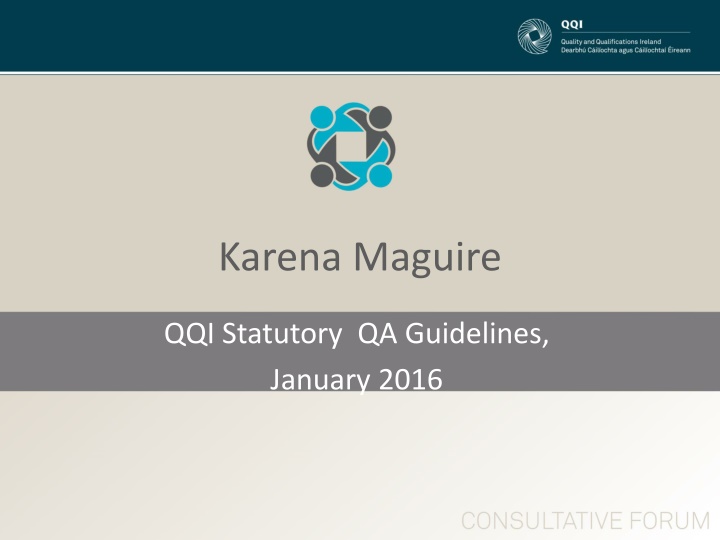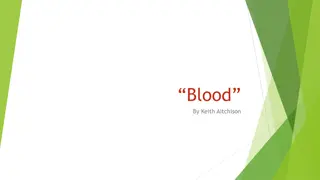Karena Maguire
Quality assurance plays a crucial role in ensuring that education and training providers offer services that meet their intended purposes and uphold standards. The guidelines outline expectations for the quality of provision, assessment, and the teaching and learning experience in the Irish education and training community. They emphasize the importance of accountability, transparency, and continuous improvement to enhance the overall quality of education and training services.
Download Presentation

Please find below an Image/Link to download the presentation.
The content on the website is provided AS IS for your information and personal use only. It may not be sold, licensed, or shared on other websites without obtaining consent from the author.If you encounter any issues during the download, it is possible that the publisher has removed the file from their server.
You are allowed to download the files provided on this website for personal or commercial use, subject to the condition that they are used lawfully. All files are the property of their respective owners.
The content on the website is provided AS IS for your information and personal use only. It may not be sold, licensed, or shared on other websites without obtaining consent from the author.
E N D
Presentation Transcript
Karena Maguire QQI Statutory QA Guidelines, January 2016
QA in General Quality Assurance In an education and training context, quality assurance has to do with matters such as: whether the education, training, research and related services provided by a provider are fit for their professed purpose; the trustworthiness of the qualifications awarded or recognised; accountability, openness and transparency; and the standards of awards. In all cases, quality assurance is the responsibility of the provider.
QA Guidelines Communicate expectations about the quality of provision, assessment and the teaching and learning experience in the Irish education and training community; Bring greater coherence into, and between, different parts of the education and training system; Are the starting point for providers establishment of their own QA procedures. are a springboard for improvement and enhancement for all providers, not a compliance checklist; Will be adapted and continuously evolve to remain fit-for-purpose for the needs of the education and training community and the qualifications system; Can be expected to have different purposes and different impacts in each sector and topic that they address. The impact of the guidelines upon a provider will depend upon the scope of their provision and the sector in which they operate.
QA Guidelines Do not prescribe the manner in which providers must implement their QA procedures. Are intended to guide providers through their legal responsibilities for the development of quality assurance procedures Providers shall have regard to when establishing QA procedures Focus on a provider s scale and scope of activity will determine the level of complexity of their QA procedures Highlight the central role of the Internal provider QA system
Core 1 applicable to all providers Significant overlap in requirements general statutory requirements European International Standard practice Recognition that providers have more diverse provision (HE & ELT/HE& FE&ELT/ ) less burden in one core Assisting inter-institutional collaboration (Consortia) One core for learners and stakeholders
Core SQAGs: Chapters GOVERNANCE AND MANAGEMENT OF QUALITY Governance Management of Quality Assurance DOCUMENTED APPROACH TO QUALITY ASSURANCE PROGRAMMES OF EDUCATION AND TRAINING STAFF RECRUITMENT, MANAGEMENT AND DEVELOPMENT TEACHING AND LEARNING ASSESSMENT OF LEARNER ACHIEVEMENT SUPPORTS FOR LEARNERS MANAGEMENT INFORMATION AND DATA PUBLIC INFORMATION AND COMMUNICATION OTHER PARTIES INVOLVEMENT IN EDUCATION AND TRAINING SELF-EVALUATION, MONITORING AND REVIEW
Guidelines for Apprenticeship SECTION 3 GUIDELINES : DEVELOPMENT STAGES 3.1 QQI QA GUIDELINES 3.2 PARTNERS FOR APPRENTICE FORMATION 3.3 AWARDS, PROGRAMMES AND CURRICULA 3.4 OCCUPATION APPROVAL PHASE 3.5 ACCESS TO QQI VALIDATION 3.6 THE ORGANISATION OF THE GUIDELINE SECTIONS 3.7 GUIDELINES TO THE PRE-VALIDATION PROGRAMME DEVELOPMENT STAGE SECTION 4: GUIDELINES TO THE OPERATIONAL PROGRAMME STAGE 4.1 OCCUPATIONAL MEMORANDA OF AGREEMENT AND MEMORANDA OF UNDERSTANDING 4.2 PROGRAMME PROVISION 4.3 ASSESSMENT OF APPRENTICE ACHIEVEMENT 4.4 MANAGING AND MAINTAINING QUALITY IN APPRENTICE PROGRAMMES 4.5 PERIODIC REVIEWS OF OCCUPATION, THE CONSORTIUM AND THE PROGRAMME
Guidelines for Apprenticeship SECTION 5 SUPPORTS FOR APPRENTICES 5.1 GENERAL ISSUES 5.2 DUTY OF CARE TO YOUNG APPRENTICES 5.3 INTEGRATION INTO OFF-THE-JOB INSTITUTIONS 5.4 DEALING WITH COMPETING RESPONSIBILITIES 5.5 SPECIAL EDUCATIONAL AND TRAINING NEEDS OR DISABILITIES SECTION 6 INFORMATION PROVISION 6.1 MANAGEMENT INFORMATION AND DATA 6.2 PUBLIC INFORMATION SECTION 7 APPENDIX 1 GUIDELINES ON THE DRAFTING OF MEMORANDA OF AGREEMENT
Timeline for consultation 15 February, 2016







